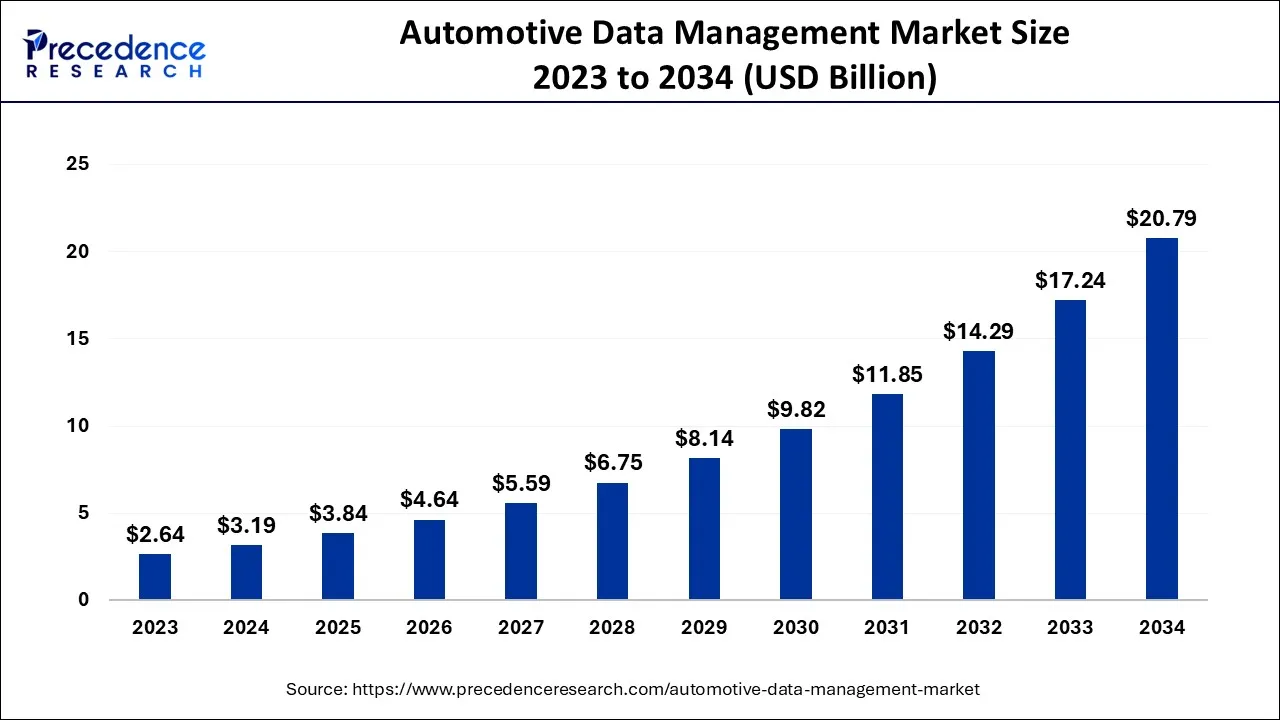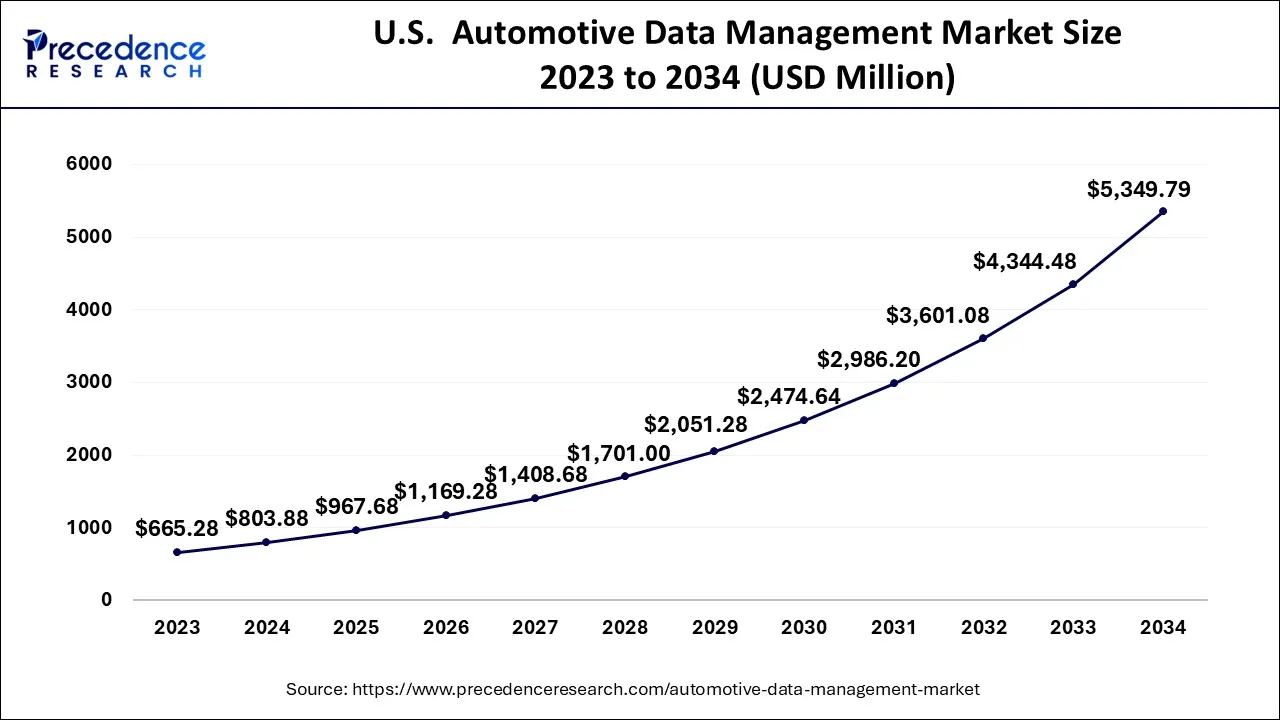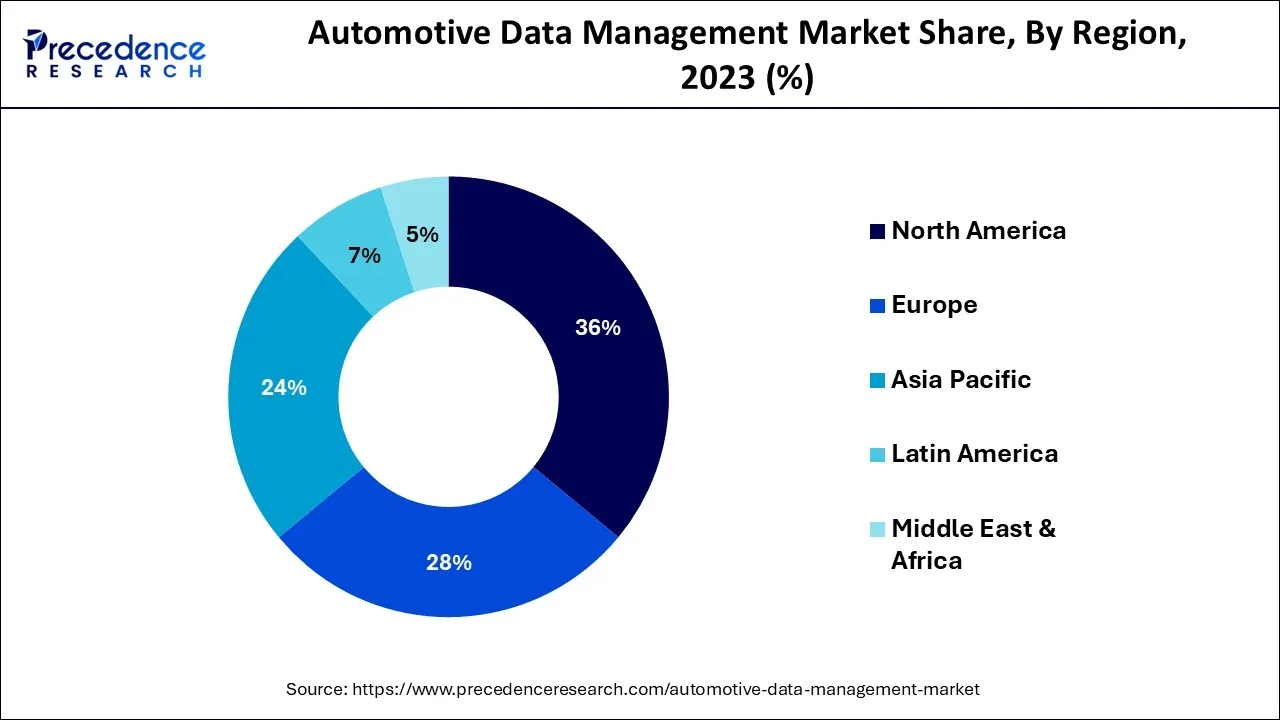January 2025
The global automotive data management market size accounted for USD 3.19 billion in 2024, grew to USD 3.84 billion in 2025, and is expected to be worth around USD 20.79 billion by 2034, registering a healthy CAGR of 20.62% between 2024 and 2034. The North America automotive data management market size is predicted to increase from USD 1.15 billion in 2024 and is estimated to grow at the fastest CAGR of 20.78% during the forecast year.
The global automotive data management market size is expected to be valued at USD 3.19 billion in 2024 and is anticipated to reach around USD 20.79 billion by 2034, expanding at a CAGR of 20.62% over the forecast period 2024 to 2034. Automotive data management refers to collecting, storing, processing, and analyzing data generated by vehicles, drivers, and passengers. With the increasing use of connected cars, the volume of data generated by vehicles has increased significantly, creating a need for advanced data management solutions in the automotive industry.

The U.S. automotive data management market size is exhibited at USD 803.88 million in 2024 and is projected to be worth around USD 5,349.79 million by 2034, growing at a CAGR of 20.87% from 2024 to 2034.

Over 36% of global income was generated in North America in 2023, and it is expected that this region will continue to dominate during the projection period. The market in the region is being driven by elements like the existence of major market sellers, significant discretionary incomes, demand for new cars, and the high usage of advanced technologies in the area. Additionally, the increased testing and use of self-driving cars as a result of changes to traffic laws in the U.S. that permit them to communicate with one another on freeways and roads has increased demand for automotive data administration in the area.

Over the forecast time, Europe is expected to grow at the greatest rate of 19.4%. The development of the regional market is primarily attributable to improvements in the design of vehicle electronics, greater vehicle production, advances in vehicle-to-vehicle (V2V) and vehicle-to-infrastructure (V2I) communication, increasing linked vehicle sales, and the rise of significant OEMs. The market for linked cars is growing considerably thanks to Europe. Additionally, regional business actors are creating cutting-edge and ground-breaking vehicle data administration goods and services for customers.
The growth of the market is driven by factors such as the increasing demand for connected cars, the growing focus on vehicle safety and security, and the rising adoption of advanced technologies such as artificial intelligence (AI) and the Internet of Things (IoT) in the automotive industry.
The global automotive data management market has experienced significant growth in recent years, driven by the increasing adoption of connected cars, the rising demand for real-time data analytics, and the need for efficient data management. The COVID-19 pandemic has also contributed to the growth of this market, as the shift towards remote work and online services has accelerated the need for digital transformation in the automotive industry.
The increasing demand for advanced analytics tools, such as artificial intelligence and machine learning, is expected to drive the growth of the automotive data management market further. These tools enable automakers to gather and analyze data from multiple sources, including vehicles, sensors, and customer interactions, to gain insights into customer behavior, preferences, and needs.
Moreover, the growing focus on data security and privacy in the automotive industry is expected to drive the adoption of data management solutions that offer advanced security features such as encryption, data access controls, and threat detection. These solutions help automakers comply with various data protection regulations, such as the General Data Protection Regulation (GDPR), and mitigate the risk of data breaches.
Cloud-based data management solutions are also expected to witness significant growth in the automotive industry, as they offer several benefits, such as scalability, cost-efficiency, and accessibility from anywhere. These solutions enable automakers to store and access data from anywhere, which is particularly important in a global industry like the automotive.
| Report Coverage | Details |
| Market Size in 2024 | USD 3.19 Billion |
| Market Size by 2034 | USD 20.79 Billion |
| Growth Rate from 2024 to 2034 | CAGR of 20.62% |
| Largest Market | North America |
| Fastest Growing Market | Europe |
| Base Year | 2023 |
| Forecast Period | 2024 to 2034 |
| Segments Covered | By Component, By Data Type, By Vehicle Type, By Deployment, and By Application |
| Regions Covered | North America, Europe, Asia-Pacific, Latin America and Middle East & Africa |
Increasing demand for connected cars
One of the major factors propelling the worldwide market for automotive data management is the rising demand for linked vehicles. The performance, location, and use of connected vehicles produce enormous amounts of data. Automotive data management systems can assist manufacturers and other stakeholders in gathering, processing, and analyzing this data to enhance driver safety and vehicle performance.
Another important factor propelling the global car data management market is the rising popularity of electrified vehicles. Compared to conventional internal combustion engine vehicles, electric vehicles produce various kinds of data, such as battery charge level and energy usage. Automakers and other stakeholders can handle this data and improve vehicle performance with the aid of automotive data management tools. The market is expanding as a result of developments in the car industry like lightweight vehicles and electric mobility.
Data privacy issues
One of the key industry inhibitors for the global vehicle data management market is data privacy issues. Concerns about the security and safety of private data, such as driver behavior and position information, are raised by the gathering, processing, and analysis of vehicle data. To prevent data leaks and cyberattacks that would impede the development of the Automotive data management market, automakers and other players must make sure they are in compliance with data protection laws and put in place effective data security measures.
Rising usage of cloud-based options and rising demand for data analytics
One of the major business possibilities for the global automotive data management market is the rising demand for data analytics. Automakers and other stakeholders can use automotive data management systems to evaluate massive quantities of vehicle data to spot trends and patterns, allowing data-driven decision-making and performance improvement of vehicles. Another significant business potential for the global automotive data management market is the growing use of cloud-based solutions. Businesses of all kinds prefer cloud-based solutions because they are more adaptable, expandable, and affordable than on-premises alternatives. By providing cloud-based solutions that allow for real-time data access and insights, automotive data management solutions can capitalize on this trend.
Over 76% of the total income in 2023 came from the software sector, which is anticipated to hold onto first place throughout the forecast period. This is explained by the rising interest in and use of car software among end consumers like fleet owners, shipping and logistics businesses, and automakers. Fuel usage, fleet awareness with telematics, and repair reports from other systems are just a few of the statistics that can be tracked using the data collected from the automotive data management platform. Managers can use this data to evaluate metrics and make choices based on current data. The industry has been divided into software and services based on components.
Over the forecast period, the service sector is anticipated to expand at a pace of 22%. Managed services and subscription-based services are both included in the automotive data administration program. Over the projection period, the segment's development is anticipated to be driven by the increasing demand for customized value-added data management services among end users like auto dealers, automakers, and fleet owners. Automotive data management services aid in enhancing car performance and give businesses centralized storage scalability, insights, and ease, assisting them in better client experiences.
Over 56% of the total income in 2023 came from the sector of structured data, and it is anticipated that this segment will keep leading throughout the forecast period. Highly ordered data known as "structured data" is handled, saved, and retrieved with ease by basic search engine algorithms. The demand for structured data by automobile makers to improve the design of driverless cars is a major factor in the development of this market. The industry has been divided into two categories based on the sort of data: structured data and unstructured data.
Over the course of the projection period, the unstructured data market is anticipated to grow at a CAGR of 19.58%. Autonomous, linked, and non-autonomous cars use LiDAR and other devices to collect a lot of unstructured data. Cloud technologies are being embraced by participants in the automotive industry to keep unstructured data about vehicles. In order to advance the creation of driverless vehicles, unstructured data is useful.
In 2023, the non-autonomous category ruled the market with a share of over 56%. Over the forecast period, the non-autonomous sector is anticipated to hold onto its place. Without human assistance, non-autonomous cars are unable to operate. Automotive data management has applications in linked automobiles, which are non-autonomous vehicles. Data is generated by connected vehicles based on various factors, including speed, motor condition, and distance traveled. The information obtained from the vehicle's entertainment system, controller access network, and electric control unit helps to improve the driving experience. The information gathered can be put to use in a variety of ways, including predictive management, in-car purchases, traffic management, usage-based insurance, fleet management, and emergency roadside help. The industry has been divided into autonomous and non-autonomous vehicles based on the sort of vehicle.
Over the forecast period, the autonomous sector is anticipated to expand at a pace of 21.40%. The creation of adaptive algorithms, sensor-processing technologies, high-definition mapping, and the deployment of vehicle-to-infrastructure (V2I) and vehicle-to-vehicle (V2V) transmission technologies are all factors contributing to the segment's rise. With the help of all these technologies, many businesses are expanding their production capacities and elevating car automation. Autonomous vehicles now make extensive use of technologies like cloud processing and artificial intelligence (AI) for improved usefulness.
Over 61% of the total income in 2023 came from the cloud sector, and it is anticipated that this segment will keep leading throughout the forecast period. Cloud computing is becoming more and more common in linked and autonomous cars. The industry has been divided into on-premise and cloud implementation segments.
The adoption of cloud technologies is reshaping the car business by enabling greater scalability, quicker time-to-market, increased dependability, and enhanced cost-efficiency. For the car business, several software developers are making investments in cloud-based technologies. For instance, Amazon Web Services, Inc. will introduce "AWS FleetWise," a new cloud-based data tool, in November 2021. It enables automakers to collect and access sensor and telematics data from their inventories of vehicles.
Over the forecast period, the on-premise sector is anticipated to expand at a pace of 18.90%. On-premise software is put on actual technology that belongs to an organization, is situated on its actual property, and is typically housed in its own data center. Because it can directly reach the data with on-premise, IT staff has more control over the server infrastructure and the security, data configuration, and administration.
The driving and user behavior analysis category had the highest revenue share of over 31% in 2023, and it is anticipated that it will keep leading the market throughout the projection period. The use of a variety of techniques, such as face recognition, physical feature monitoring, onboard telemetry data collection, driving style evaluation, and physical condition tracking of the driver, can be credited with the segment's development. Predictive maintenance, guarantee analysis, safety and security management, driver and user behavior analysis, and vendor performance analysis are the market segments based on application.
Over the course of the evaluation period, the predictive maintenance market is projected to grow at a CAGR of 21%. The automotive industry's growing demand for and implementation of predictive maintenance solutions, which foretell car problems and alert owners to crucial maintenance needs before a failure happens, can be credited with the development of this market niche.
ACTIA and Sibros Technologies Inc. signed a strategic collaboration agreement for the ACU6 telematics technology in March 2022. For OEM automakers in the motorbike, heavy-duty haulage, and light passenger sectors, this joint solution is anticipated to improve linked vehicle design and innovation.
Segments Covered in the Report
By Component
By Data Type
By Vehicle Type
By Deployment
By Application
By Geography
For inquiries regarding discounts, bulk purchases, or customization requests, please contact us at sales@precedenceresearch.com
No cookie-cutter, only authentic analysis – take the 1st step to become a Precedence Research client
January 2025
April 2025
January 2024
January 2025